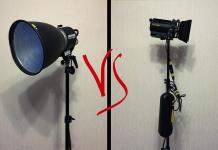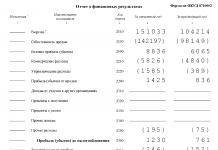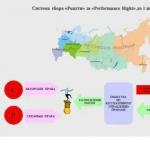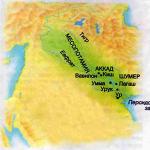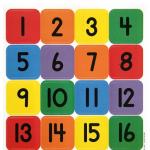Pulsed light vs constant light. lisits wrote in April 7, 2016
One of the long-standing insoluble dilemmas, standing in the hierarchy somewhere between “film vs digital” and “canon vs nikon”, is the question “constant or pulsed light?”

I found the following answers to this question:
“We see constant light immediately, but we only imagine pulsed light.”
I don't consider this to be an answer, but rather a logical consequence of the definition. It's like saying: you can shoot video with constant light, but not with pulsed light. Come on?!
- “The only difference is in power.” As evidence, they provide two frames of some stand a meter from the background, taken by one source on the impulse and the pilot.
Yes, under such conditions there really is no difference, but these are rather particularities.
- “Constant light is more pleasing to the eye and (my favorite) - creates a cinematic picture.” The concept of “cinema” is so vague that it’s time to write a separate article. I agree, constant light is indeed more pleasant than flashes in work, but only the final result matters, and it largely depends on the approach.
A huge amount of information has already been written on this topic, and it has long been known that it is impossible to say which light is better, and that everything depends on the tasks. I will begin my research with the idea that, in principle, absolutely any problem can be solved with any light. Another thing is that some kind of light will solve these problems easier and/or cheaper. Therefore, in order not to be scattered, I decided to take a pulse head with a reflector and one 150W deadlight.
1. Let's put all the obvious things in the first point. This is power: even at the very minimum, the pulsed source is ahead of the Dedik in a narrow beam at the maximum by almost 5 steps. The weight advantage is usually given to pulsed light (referring to on-camera flash), but in our case the deadlight convincingly wins. plus the ease of installation and configuration. This is also energy consumption: in terms of mobility, pulsed light is far ahead (for me this is a determining factor). The concept of cost is still more equivalent to the class of equipment, but if you farm collectively, then with constant light.
2. The second point is about work. Indeed, it is much more pleasant to work with constant light: the sources are quickly adjusted, they are convenient to move and hide in the frame. Visible light greatly simplifies the work. And the main advantage: getting a narrow beam of light is much easier with constant light. One big disadvantage: when we work away from the network, the count is in minutes, not in the number of frames. If you want to take a break, you run, turn off all sources. The second disadvantage: they heat up significantly.
Power is not an end in itself, but it dictates the size of the location, and when, for example, it is necessary to fill 200-300 square meters of space, it is more logical to take impulse. Working with impulse is also interesting, but here another factor comes into play: extraneous light.
Whether we want to plant the sun or use table lamps - all this is a decisive point when choosing equipment. But something else is important here - endurance. When working with pulsed light, we can dose extraneous light separately from the pulse; when working with constant light, the shutter speed works for the entire light. This also affects work. It’s funny that working with shutter speed is usually considered a plus for constant light, but for me it’s different.
In terms of time spent, when working with constant light, I personally spend 2 times less time per frame than with a pulse, but this varies from person to person.
3. Let us finally move on to the light itself. Physically, both pulsed and constant light work according to the same laws, so some differences relate rather to the devices, and they can vary.
Pulsed light has much more contrast. The point is both in the differences in brightness between the illuminated and unlit areas, and in the structure of the light itself. I have a couple of theories here.
The dependence of light intensity on distance obeys the inverse square law: as the distance increases, the intensity decreases by the square of the distance multiple. However, geometric optics considers ideal light from a point source, which does not exist in nature.
I decided to conduct an experiment. First example: a Hensel light with a reflector at a minimum power of 37.5 J.

By measuring, we obtained a decrease in light by 2 stops (4 times) with an increase in distance of 2 times and by 3 stops with an increase of 2.5 times. Thus, we can conclude that the pulse is approaching its characteristics to a point source.
And this is what we see with a 150W dedolite in a medium-width beam.

When increasing the distance by 2 and 2.5 times, we see a decrease in light by 1.6 and 2.4 stops, respectively. The decrease in intensity is less! Why is this so?
I assumed that the problem was in the lens - after all, pulsed light with an open lamp, but most permanent sources are lensed. In order to confirm the theory, I decided to conduct a similar experiment with a flashlight with and without a lens.
Pay attention to how wonderfully the color floated (BB settings are the same).

The flashlight in a wide beam, as well as without a lens, also showed a drop in intensity of 2 and 3 stops, respectively.

But when the beam is narrowed, the drop in intensity is not so pronounced: by 1.6 and 2.2 stops, respectively.
From this we can conclude that lensed light sacrifices contrast for controllability. And given that almost all constant light sources are lensed, this also matters when choosing light.
You need to understand that the examples I give are “laboratory”, and as the distance increases, these proportions will change. However, even at such small distances it is clear: pulsed light is inherently more contrasty. But it’s easier to get a narrow beam of light at a long distance with a Dedolight.
The results I obtained do not work with wide sources such as LED panels and softboxes - the law of inverse distance works there.
I have another theory: the work of diffraction. The fact is that the constant light shines constantly, and the flash lamp has time to flare up and die out. This already applies to the wave theory of light, which I have not delved into, but it should have an effect.
4. I also tried this experiment with a 1200J pulse and this is what I got.

Intensity drop by 1.7 and 2.5 stops!
The reduction in light incidence in this case is explained by another important property of light: reflection. This can be neglected if you are a ghoul and live in a black room, but I have a white ceiling and walls. Therefore, if I want to get the most rigid light pattern, I will choose constant light, the reflection of which from the walls can be neglected. This factor is of great importance when creating light in a room in principle. Of course, you can mess around with flags and work at low powers, but the picture will still be perceived differently than with constant light.
5. And here we come to a rather individual question - the question of perception. We are more accustomed to constant light; all the light we see day and night is constant. That is, the difference in brightness and contrast is also familiar to us. This does not give a head start to any light, but it fundamentally distinguishes the tasks.
For the sake of proof, here is a comparative picture of a 37.5 J pulse and a flashlight in a wide beam. Both showed the same drop in intensity.

I don’t know about you, but it seems to me that the top row has more contrast and that the light difference is stronger, although according to the measurements everything is the same.
6. Upd: I forgot to mention another important factor for me. The fact is that I shoot both digital and film. Experience has shown that shots taken with pulsed light often require modification in photography. And, despite the dynamic range, film is much inferior to digital when working with impulse. When working with permanent film, it retains all its advantages. Usually the choice of light is paramount for me, but sometimes I have to choose light based on this principle.
Bottom line: it’s impossible to say which light is better, both are better. I decided for myself this way: outdoors the light is pulsed, indoors it is constant. And also various combinations: for example, in the photo below, the impulse hits the window, and the circuit in the room is permanent.

Finally, here is a crop from different frames, guess where the impulse is and where it is constant.
Publication date: 04.04.2008
Studio photography equipment
In the photo studio we have the opportunity to create the necessary character of lighting using light sources, light-forming attachments and reflectors (reflectors). Studio light sources are divided into pulsed and constant light.
Constant light sources are powerful halogen lamps that consume a lot of electricity and produce an insane amount of heat. Therefore, they are rarely used in photography, more often in filming.
Pulsed light sources (studio flashes) consist of two lamps, the flash lamp itself and a regular “pilot” light lamp (hereinafter referred to as “pilot”) of low power (about 300W). “Pilot” is necessary in order to evaluate the cut-off pattern, and its power is not enough for shooting. Pulse sources can be divided according to their design into two types: monoblocks and generators.
In a monoblock, the controls, flash lamp and “pilot” are made in one housing, which is mounted on a tripod and plugged into a power outlet. In the generator, control elements for several sources are placed in one housing, and the lamps themselves on tripods are connected to this housing with special wires. One of the conveniences of generators is the ability to quickly control the power of several sources at once. Generator devices are usually of a higher class and have better characteristics (power, pulse duration, recharge speed) than monoblocks. Accordingly, they are much more expensive than monoblocks.
Controls (main: pulse power, pilot power) may differ depending on the manufacturer of studio equipment and the model of the device. The power scale can also be discrete and expressed either in multiples or percentages of maximum power, or indicated in aperture numbers (stops). The power of pulsed studio light sources is indicated in Joules (J). For example: 150 J, 300 J, 500 J, 1000 J.
Manufacturers of professional studio photographic equipment that can be bought in Moscow: Hensel, Bowens, Broncolor, Profoto, Rekam, Prograph, Visatec, Multiblitz, Elinchrom, “Marco”, “Marco-Pro”, Prolinca, GuangBao, Falcon, Raylab. Light shaping attachments. Attachments are hanging structures that are attached to light sources through a mechanical connection (bayonet) and serve to change the nature of the light flux.
Character of light
Directional light (hard, sharp) - light that produces sharp transitions of light and shadow on an object and, in some cases, glare (example: spotlight, bright sun, any point light source).
Diffused light (soft, shadowless) - light emitted by a large surface, uniformly and equally illuminating the object, as a result of which there are no sharp shadows or glare (example: light from a window covered with a white curtain, reflected light from a light wall, cloudy cloudy weather - reflection of light from the clouds). Separation of nozzles according to the nature of light:
Directional light - tubes, “plates”, honeycombs, etc. Diffused light - umbrellas (sometimes reflected or transmitted), soft boxes and their varieties, etc.
Reflectors
Passive lighting equipment. The light itself does not emit, but only reflects (or shines through), allowing you to change its direction, character, and color temperature. Usually it is white, black, gold or silver fabric, dressed on a round or rectangular frame.
Pulse synchronization
Pulse synchronization is the simultaneity of the light pulse and the opening of the camera shutter. Let's list the main methods of synchronizers: IR trigger, sync cable, camera flash.
IR trigger is a universal synchronization method. This is a small box that attaches to the location of your camera's external flash (the so-called hot shoe).
Synchronization occurs through an infrared pulse, since the monoblocks have corresponding trap devices.
Sync cable - synchronization through a wire that is connected to the sync connector on the light source and to the camera's sync connector. The types of connectors vary from manufacturer to manufacturer.
Flash - your camera's built-in or external flash “sets fire” to other light sources (they have “traps” installed in them). In order to prevent the interference of light from the camera flash in the light picture, it is necessary to cover it (for example, with a piece of cardboard) and reduce its power.
In most cameras, the flash works like this: it fires an evaluation pulse necessary to determine the exposure, and then the main pulse. The eye usually perceives these two flashes as one, but the “traps” in the light sources are triggered by the first pulse, resulting in an underexposed frame. Solution: either turn off the evaluation pulse in the camera or flash (if possible, for example, on Nikon cameras), or use the “exposure memory” button.
Sometimes there are pulse sources that can pass the first evaluation pulse and trigger on the second, but this is rare, and all monoblocks in the studio should be equipped with this function. This is why the camera flash synchronization method is inconvenient.
Radio synchronization - synchronization over a radio channel. Usually this is a set of receiver and transmitter. The receiver is plugged into the sync connector of the light source, the transmitter is attached to the camera, just like the IR trigger. Pros: it does not “blind” in the bright sun, Japanese tourists will not disturb with their flashes during an outdoor photo shoot.
Exposure metering when working with pulsed light
Expo automation of modern cameras is not designed to work with studio pulsed light. It is impossible to determine exposure using the camera! Therefore, studio photography is carried out exclusively in the manual mode (M, Manual) of the camera.
Matrix sensitivity
Shoot at the lowest sensitivity available for your camera to avoid digital noise. I also strongly recommend shooting in RAW rather than JPG.
Excerpt
The pulse duration of monoblocks is extremely short. Therefore, we set the so-called X-sync shutter speed in the camera (usually 1/200–1/500 sec.). Sync speed is the minimum shutter speed at which the shutter is fully open. If you set the shutter speed lower (shorter), you will get the unexposed (black) part of the frame. If you set a longer shutter speed, this will not affect the result, because the power of pulsed light is high compared to natural light in the studio, and the duration of the pulse is short.
Conclusion: when working with pulsed light in a photography studio, it is impossible to control exposure using shutter speed. Aperture is the only way to control exposure when working with pulsed sources, with the exception of changing the power of the light sources or changing the distance from the source to the model.
Determining the correct exposure
We have already understood that we can influence the exposure with the aperture and power of monoblocks, but how to determine the correct exposure? Let's consider two options.
- Flash meter
To determine the correct exposure (correct aperture), there is a flash meter. Essentially, this is an exposure meter that, unlike the one built into the camera, can work with pulsed light. To use the flash meter, just read the simple instructions.
- Brightness histogram
If you don’t have a flash meter, don’t despair. A digital camera has the ability to display a histogram of the captured frame. A brightness histogram is a graph of the distribution of halftones in an image, in which the horizontal axis represents brightness (halftone gradations from black on the left to white on the right), and the vertical axis represents the relative number of points with a given brightness value (the higher the column, the more points).
By examining the histogram, we can get a general idea of the correct exposure (determine overexposure and underexposure) and estimate the required change in exposure. When shooting, you just need to strive to ensure that the histogram does not rest against the top edge, which means “underexposure” (left side) or “overexposure” (right side), and, if possible, monitor the uniform distribution of the histogram horizontally (depending on the specifics of a particular frame) .
There are occasional debates online about what type of lighting to use. Traditionally, photography has always used different types of pulsed light because constant light studio lights were very heavy, very expensive, and consumed a lot of electricity.
But now, as the cost of constant light begins to come down and we see more and more powerful, even spectrum, daylight-matched lighting products hitting the market, the question of the benefits of constant light is once again becoming relevant.
“Light painting”, but how much light is enough?
Perhaps you are new to lighting and want to get the most out of your money on light purchases, or at least get a brief introduction to the topic. In this article I will try to give a brief overview of the possible options and criteria for making a decision. Today we will compare the advantages of each system.
Pulsed light
1. Power!
Pulsed light sources will give you much more light output than constant lights at any comparable cost, size, or any other parameter. Why is that? Because a constant light source must reflect photons from objects into the lens as long as the shutter is open. A pulsed source can instead store as much energy as needed in a relatively short time, and then release large amounts of energy easily and instantly.
Let's use a little arithmetic to demonstrate this idea. Let's say you have five 60-watt halogen lamps. You get about 5500 lumens of light, 17-18 lumens per watt of power consumption. Since the light is constant, every second this 300-watt source will emit 5,500 lumen-seconds of light. Lumen seconds can measure the emission of light regardless of duration.

1sec., f/9, ISO100. The white balance of the light source is from 3500K to approximately 2950K. The dark strip has the same view illuminated by natural light.
Take a pulse source with a xenon gas discharge tube that produces about 100 lumens per watt. We use a relatively weak 60-watt pulse and assume that the manufacturer did not cheat with the indicators and the flash electronics are highly efficient. If we multiply lumens/watts by watt-seconds, we get lumen-seconds. So the lumen-second output would be around 6000.
Well, it's quite a bit higher than constant light! Yes, but keep in mind that all those lumen-seconds will actually be emitted in about 1/2500 of a second. Let's take lumen seconds, divide by seconds, what do we get?
6000/ 1/2500 = 6000*2500 = 15,000,000 lumens! In reality the light output will be closer to 10,000,000 lumens due to optical and electronic losses. This makes it easy to overpower the sun, illuminating large rooms or hills or waves for a short moment. After all, we are engaged in photography - so we only need a short moment to take a picture.

1 sec.,f/9, ISO 100. You could use 1/250 sec. with approximately the same result. Compared to the previous photo, this one is 3.4 stops brighter!
Since energy is the product of force and time, a 160 Watt-second monoblock stores 160 Joules in capacitors, and a 300-Watt fluorescent tube uses 300 Joules of energy in one second. Twice the power and ten times less light!
So if you need a lot of power for a big job or want to overpower daylight - the best option is to use a flash light.
size 2
Pulsed light allows you to have the sun in a package the size of a coffee can. You can light up a room like on a sunny day with a source that fits in your hands and weighs a hundred grams. If you are doing or planning to shoot outdoors, pulsed light is much more convenient.
To create a constant light of about the same power as a pulsed one, you would need to use several high-power Fresnel lamps, which consume approximately 4-20 kilowatts, weigh about 25 kg each, and cost thousands of dollars, yet produce an output of about 100,000 - 500,000 lumens. It's this combination of power and convenience that makes pulsed light something that won't be replaced any time soon.

They are not as huge as cinema lights. Although there are even fewer.
In terms of compactness, long fluorescent tube lamps do not fold down to travel size and definitely need shock protection in addition to the set. On the other hand, a meter softbox can easily be disassembled into a truly compact size.
3. Battery powered
For both pulsed light and flashbulbs, small self-contained batteries are a common power source. LED light is constantly being improved, so that there are already real battery-powered constant light sources, but the power of their light is not yet comparable to the power of pulsed sources. With batteries, you can go anywhere with three, four or five spot lights. For work on the road, this is indispensable.

Look - no wires! Many editorial photographers use flash kits for shooting in any conditions.
Flash units use AA batteries, or you can connect a high-voltage booster to speed up recharging. Lithium battery packs with a built-in inverter allow you to take your studio light anywhere, just like camera flashes. This is especially appropriate for small, rugged all-in-one PCs like the AlienBees.
4. Color
The spectral emission of xenon discharge tubes is such that they have a color rendering index (CRI) of about 100. CRI is a measure of how well the light illuminates colors without altering them due to peaks or valleys in the spectrum of the emitted light.
The closer it is to the continuous spectrum (regardless of color temperature), the better. The index for incandescent lamps is also 100, but for other constant light sources such as halogen lamps, fluorescent lamps or LEDs, it is no more than 95. By the way, if you are looking for constant light, know that a factor of 80-90 is “good” , and 90-100 is “excellent”. In general, it is better to choose light with a coefficient of 91 or higher.

CRI>93, but at $8 per lamp. Color accuracy doesn't come cheap. And it still falls short of a regular flash.
In addition to excellent color rendering, xenon gas discharge tubes have a coating that gives them a daylight color temperature of about 5500 K, which ensures their applicability in a wide range of situations and adds another advantage to those already described.
5. Price
The cost per lumen-second (or watt-second) is much lower for pulsed light. The same applies to a large extent to the power and color requirements, which are also difficult to achieve today at a reasonable price with constant light.
Fluorescent light appears to be most effective with T-5 bulbs, which produce 5,200 lumens with a CRI of 93, and compact fluorescents, which produce 4,800 lumens with a CRI of 91.

You can buy two flashes for the price of the lamps and ballasts in this picture!
A good manual flash can be purchased for less than $100, and with TTL - about $200. Four powerful T-5 lamps will cost about $35, not counting the lamp itself and the electronics to operate it, which will add another $150 to the cost. This is if you collect everything yourself.
Cool Lights and KinoFlos costing between $500 and $1500 are no brighter than a flash. A 160-watt pulse monoblock costs less than $250. Adding the cost of a 12x48-inch stripbox, even from an expensive manufacturer like Lastolite, still won't match the cost of a quality fluorescent light.
Constant light
It appears that pulsed light is superior to continuous light in all directions. But is it? We haven't considered all the factors yet. Let's look at the benefits of constant light.
1. WYSIWYG
“What you see is what you get” (from the translator - this is what the abbreviation in the title stands for). With constant light there is no need for a modeling light, which generates a lot of heat and may limit you from using some light modifiers. You will immediately see exactly what the camera sees.
This can be a great help when learning to work with artificial light as you can move the light around and immediately see the result without having to shoot the shot at all.

It so happened that I used a modeling light as a permanent light in this shot, but any old-fashioned table lamp could have taken its place.
The ratio of light from sources directly in front of your eyes. No flash meter, no need to shoot in manual mode, just switch light settings until you like the result. And then adjust the aperture and ISO on the camera. One can only dream of such a learning process!
And your model will see what happens. Without sudden flashes of light everywhere - she may just have to get used to the high light levels.
2. Do it yourself
If you like to do everything yourself, then it will be much easier, safer and perhaps even cheaper to follow the path of constant light. A homemade fluorescent source can be assembled for about $150-200. A flashlight with several powerful compact fluorescent lamps in a large housing will cost about $200-250.
Compared to buying a pulsed light, the price is comparable. Compared to trying to disassemble, remodel, or make one yourself, a pulsed light source is a safety factor like night and day. No high wattage, no high voltage, no capacitor banks to worry about, no discharge channel.
Although in principle it is possible to assemble an inexpensive pulsed light source yourself, if you are not an electrical engineer, it is better to leave this to specialists. And don't forget that fluorescent lamps contain mercury vapor!

Almost everything you need for self-assembly - almostKinoFlo. Of course, not for $200, but still cheaper than the four-digit price of the original.
Even if you are not a DIYer, constant light still has huge potential for “alternative uses.” Want KinoFlo? Buy a greenhouse light for $150. Want as much light as possible? There are countless old lamps and lamps being sold for a couple of dollars. Unlike pulsed light, there is no reason to only use light specifically designed for shooting. Although pulsed sources may be more useful for photography, they are quite a significant investment.
3. Advantages of low power
Lower constant light output is not always a disadvantage. If you like to take bright pictures, but with an open aperture and a shallow depth of field, then constant light will suit you well.
If you're shooting food, produce, still life or other static subjects, aperture won't be an issue since you don't need to use motion-stopping shutter speeds. The light can be adjusted to your liking and the shutter speed won't matter much. This can be done with pulsed light using a neutral gray filter, but it's still good to see what's in focus!

Straight from the camera. Is it possible to determine whether the shutter speed here was a full second long or 1/250 s? I can not.
4. Light quality
This is a very subjective point and we can only talk about personal impressions, but perhaps you have noticed that there is some difference in the quality of softened pulsed and constant light? Personally, I have always found the quality of constant light more pleasant.
Perhaps because there is “real” dispersion with constant illumination over the area, and not falling towards the edges as with pulsed light with software. This, of course, applies primarily to long fluorescent lamps. LED panels are usually not big enough to see this effect, but I think it's the same.
Others say that light is light and from a physics point of view I agree with them. But the constant light also has some soft clarity that I cannot explain.
5. Video
The video capabilities of constant light should also not be overlooked, especially today, when more and more photographers are asked to shoot video with DSLRs. The ability to use existing light for video shooting can be a competitive advantage for a potential client with extensive needs.
You can also experiment with using a constant light source on your camera to see how the lighting of your subject changes as you move around it, giving you an advantage over flash photographers.
Which light to buy
Actually... I'll say both. Each of them is a separate tool for its tasks and as you can see from the illustrations, I am currently working on using a permanent one. Sometimes it is even possible to use both types at the same time: for example, setting a light pattern using constant light together with freezing the characters with a pulsed source on the second curtain. Another example would be shooting portraits with fashionable constant main light sources that provide comfort for the eyes of the portrait subject, while backlighting with a pulsed source.
Either way, it depends on your specific needs. Are you looking for power and portability above all else? Choose pulsed light. Do you shoot in a studio and rarely stop down to more than f/3.5? Then I’ll recommend a permanent one. Your specific situation may be more ambiguous, so I won't be able to give one-size-fits-all advice. However, I hope that this article will give you some general understanding of the topic and help you make the right decision.
Professional photographers often resort to shooting in a studio environment in their work. In such conditions, studio lighting plays an important role, helping to create photographs that are interesting both from a professional point of view and from an artistic point of view. The required level of lighting in the studio is achieved using a special device - a lighting lamp mounted on a tripod. Using a tripod, the lamp can be easily moved and installed in the desired positions. In practice, two options for studio lighting are used - lighting pulsed light source and lighting constant light source. The first works on the principle of generating short flashes, the second provides stable light.
Pulsed studio light source
Pulsed light is generated by a lighting device where two types of lamps are present. One lamp, the so-called pilot- design with a reflector and high linear characteristics regarding the correspondence between light power and pulse energy. The power of such a lamp usually varies between fifty and three hundred watts. The device is ideal for identifying shadow areas and modeling light patterns. The second lamp is a pulse lamp. Structurally, it has two or three electrodes, one of which is igniting. The operating principle is based on the generation of an electrical discharge between electrodes in a gaseous environment. flash tube is a highly impulsive light source whose power is measured in joules. For its own needs, any professional photographic studio usually uses flash lamps with a power ranging from fifty joules to two and a half thousand joules.
In addition to standard point-action flash lamps, photo studios also use sources of other types - linear, ring and others. In the process of photographic shooting, both a flash lamp and a pilot lamp are used, but each, so to speak, in its own time. The flash lamp lights up at the moment when the photographer presses the shutter button and the camera performs its main action. At the same moment, the pilot lamp goes out and lights up again immediately after the completion of the pulse flash. The exact coincidence of the moment of shutter release and the moment of flash of the flash lamp is of great importance in the photography process. Therefore, in order to ensure the accuracy of the coincidence of moments, they resort to the use of special devices - synchronizers.

Monoblocks and generators
A model of a pulsed studio light source can have the following design: monoblock either in the form generator. The monoblock can be considered the most common design used by photographers. The system is a device from the “ all in one"when the structure contains all the elements: lamps, electronic units, control modules. This design is distinguished, firstly, by its low price, and secondly, such a technical solution makes it convenient to transport the device. However, monoblocks also have their disadvantages, including: relatively low light power, rather complex light adjustment in some cases, as well as the considerable weight of the devices.
Generators, unlike monoblocks, consist of a control unit and a lighting head. The control unit is connected to the lighting head via a cable. The generators support a universal installation mode, that is, they can be installed both on the floor and on a tripod. In this case, the devices support connecting several lighting heads to one generator unit. Other features that distinguish generators from monoblocks include the higher cost of generators and the increased power of the radiation source.

Constant light source
Other topics:
Show html code to embed in blog
What is a pulsed and constant light source?
Professional photographers often resort to shooting in a studio in their work. In such conditions, studio lighting plays an important role, helping to create photographs that are interesting both from a professional point of view and from an artistic point of view.
The success of any photo shoot depends 80% on the quality of light the photographer uses. With the help of good light you can create real masterpieces. A distant forest and field in the soft and gentle rays of sunset or a bright sunny day in a city park, a female portrait in soft colors or a male portrait with intense lighting. Every professional should be able to work with all types of lighting, and the first thing a novice photographer should do after purchasing a camera is to choose high-quality light sources that will be universal in relation to all lighting requirements. Let's try to understand what advantages and disadvantages pulsed and constant light sources have.
Constant light sources
Daylight or the LEDs on your flashlight are constant light sources. They provide lighting at any time that is convenient for the photographer, just turn on the device. Such devices have their own characteristics that should be taken into account when shooting.
The advantages of constant light sources include:
- Possibility of higher quality creating exposure before shooting. The photographer independently moves the light to create all the necessary shades in the picture;
- Save time. By using controlled constant light, you can create an exposure and capture it in one or two shots to create a masterpiece;
- Can do not limit shutter speed. You can use both long and short shutter speeds of the camera, since the lighting is static;
- No need every time before shooting change programs camera. Once you adjust to the lighting conditions, you can create an almost unlimited number of images of the same quality.
However, there are also disadvantages. Artificial constant light sources consume more electricity than pulsed ones, and also emit significantly more heat, creating discomfort in a closed room. If you use a natural constant light source, be prepared for gradual changes in its characteristics. Twilight and bright sun are completely different modes that require a different approach to shooting. The quality of the images will be greatly influenced by cloudy weather, when the sun either appears from behind the clouds or disappears behind them. Sometimes for a photo shoot you will have to wait for special weather conditions (bright sun, fog, rain, twilight, night). These are conditions that are not created according to your desire.
Pulsed light sources
Such lighting can only be artificial. To understand what a pulsed light source means, just imagine a camera flash.
Advantages of pulsed light sources:
- Mobility. Such light sources can be built into the camera, on-camera, or external, working using a synchronizer (for example, studio light). This variety of options means that you will always have the lighting that suits the situation with you;
- Adjustment. You can set all the necessary characteristics at any time convenient for you;
- Artificial pulsed light sources consume less electricity than their permanent counterparts. Closed room heats up much slower.
The disadvantages of pulsed light sources include limitations on shutter speed. You cannot set a shutter speed shorter than the synchronization time between the camera and the flash (usually no shorter than 1/200). You have to take several shots to adjust to the exposure because the shadow pattern is not visible. Such light sources do not always work, which means that due to a technical error you can lose a successful shot.
